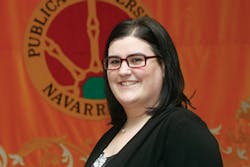BIOMEDICAL IMAGING/IMAGE PROCESSING: Algorithms enable precision image thresholding, 700x speed magnification
For her PhD thesis, Aránzazu Jurío-Munárriz, a graduate student in computer engineering at the NUP/UPNA-Public University of Navarre (Pamplona, Spain), has improved two of the algorithms most often used in digital image processing: thresholding and magnification. The formulae promise benefit for those working with biomedical images; in fact, one variation is specifically designed to facilitate analysis of brain scans.
Thresholding is used for medical image analysis to differentiate structures such as organs and tumors, so that tissue volumes can be measured and computer-guided surgery can be performed. Jurío-Munárriz explains that each pixel is analyzed so that all those sharing the same features are considered to form part of the same object. Her thesis presented a pair of thresholding algorithms, including one adapted to working with fingerprint images. She developed this one for the NUP/UPNA research group that is helping to create an identification center able to handle 40 million prints. The second thresholding algorithm is designed to facilitate study of magnetic-resonance imaging (MRI) brain scans, and highlight differences in shape or volume of certain areas in patients suffering their first psychotic episodes.
Jurío-Munárriz's magnification algorithm not only produces excellent quality images, but it does so 700 times faster less than other methods. Here again, she created a pair of methods: one for gray-scale images and the other for color images. The new algorithms allow quality to be maintained while generating compact images (to enable fast transmission via the Internet, for example) and later enlarging them.
Jurío-Munárriz's thesis, "Numerical measures for image processing. Magnification and Thresholding" has already generated six peer-reviewed journal papers on topics ranging from decision making to gait analysis; more are in process.1-6
1. A. Jurio, H. Bustince, M. Pagola, A. Pradera, and R.R. Yager, "Some properties of overlap and grouping functions and their application to image thresholding," Fuzzy Sets and Systems (in press).
2. A. Jurio, M. Pagola, R. Mesiar, G. Beliakov, and H. Bustince, IEEE Trans. Image Proc., 20, 3112–3123 (2011).
3. H. Bustince, A. Jurio, A. Pradera, R. Mesiar, and G. Beliakov, J. Euro. Oper. Res., 225, 472–478 (2013).
4. M. Galar et al., Opt. Exp., 21, 1247–1257 (2013).
5. D. Paternain et al., Exp. Sys. Appl., 39, 7729–7735 (2012).
6. M. Pagola et al., Mathware and Soft Computing Magazine, 18, 32–43 (2011).
7. P. Couto et al., Soft Comp., 15, 1937–1944 (2011).

